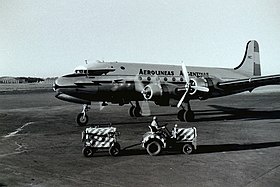Aerolineas Argentinas flight 670
| Aerolineas Argentinas flight 670 | |
|---|---|
|
An identical DC-4 from Aerolíneas Argentinas |
|
| Accident summary | |
| Accident type | Structural failure |
| place | 20 kilometers southwest of Bolivar , Buenos Aires Province Argentina |
| date | December 8, 1957 |
| Fatalities | 61 |
| Survivors | 0 |
| Aircraft | |
| Aircraft type |
|
| operator |
|
| Mark |
|
| Departure airport |
Buenos Aires Ezeiza Airport , Argentina |
| Destination airport |
San Carlos de Bariloche Airport , Argentina |
| Passengers | 55 |
| crew | 6th |
| Lists of aviation accidents | |
Aerolíneas Argentinas flight 670 (flight number: AR670 ) was a scheduled domestic flight of the state airline Aerolíneas Argentinas from Buenos Aires to San Carlos de Bariloche . On December 8, 1957, 61 people died on board a Douglas DC-4 on this flight after the machine was torn apart due to extreme turbulence in flight.
The accident was the most serious aircraft accident in Argentina up to Aerolíneas Argentinas flight 644 ; it is now the third most serious after LAPA flight 3142 .
machine
The Douglas DC-4 used was built in 1944 for the United States Army Air Forces (USAAF) as the C-54B-5DO (serial number 27227, USAAF serial number 44-9001). The United Air Lines bought the machine after the war and had it rebuilt into a civil usable DC 4th It was christened Mainliner Lake Ontario and went into operation with United Airlines in March 1946 with the aircraft registration number N30049 . In January 1957 the machine was separated and sold to Aerolíneas Argentinas, where it was operated from May 1, 1957 with the new aircraft registration LV-AHZ . The machine was equipped with four radial engines of the type Pratt & Whitney R-2000-2SD-13G Twin Wasp . It was used on tourist flights between the capital Buenos Aires and the cities of Baía Blanca and Bariloche.
Passengers and crew
55 passengers had taken the flight from Buenos Aires to Bariloche. There was a crew of six on board, consisting of a flight captain, a first officer, a flight engineer, a radio operator and two flight attendants.
Flight history
Towards the end of 1957, thousands of Argentine and foreign tourists were traveling through Argentina to spend the Christmas and New Year holidays in the tourist regions of Patagonia . In addition to bus and train connections, tourists were offered direct flights from Aerolíneas Argentinas, including flight AR670, which operated with the newly acquired Douglas DC-4.
On the afternoon of December 8, 1957, the Douglas DC-4 LV-AHZ was prepared for flight AR670 (Buenos Aires-Bariloche). After the 55 passengers and 6 crew members had boarded the machine, the DC-4 carried out the take-off run from Ezeiza Airport in Buenos Aires and took off at 3:54 p.m. heading southwest.
the accident
The flight went smoothly until the crew encountered a huge cold front outside of Buenos Aires. In order to avoid flying through turbulence, the master, who was flying the machine under instrument flight rules, raised the DC-4 from 2100 feet to 2400 feet, while the radio operator informed air traffic control that a cold front had occurred on the route. Air traffic control approved the climb via telegraph communication, as the approaching storm disrupted radio traffic.
After the brief radio contact, the crew of flight AR670 did not confirm their position again to air traffic control, which indicated that the machine was in trouble.
After the crash
At around 5 p.m., railroad workers working at the Bolivar train station heard a loud explosion. The station master assumed it was a railway accident, gathered employees and boarded a maintenance vehicle east of Bolivar. At that moment, a heavy storm with heavy rain and wind speeds of almost 100 km / h broke in over Bolivar. At one point along the railway line, railway workers saw a column of smoke rising. When they reached the site, they found a group of farmers who had rushed to the site after the explosion. The mounted group found aircraft wreckage and charred human bodies at the site. Among the dead were 13 newlyweds who had left for their honeymoon.
Salvage work
The recovery of the bodies was made difficult by the onset of the storm. The transport was finally carried out with covered wagons, trains and helicopters of the Argentine armed forces.
Accident investigation
The Argentine Civil Aviation Accident Investigation Authority (JIAAC) opened investigations a few days after the accident. After analyzing the few available data and evidence in the form of aircraft wreckage and weather reports, it was found that the machine had been accidentally flown into a storm region with wind speeds of over 100 km / h. Visibility was poor and the aircraft flew over the region at an estimated altitude of 100 to 150 meters above the ground when exposed to structural loads that exceeded the machine's operational limits. Due to the heavy loads, part of the left wing was torn off. The torn off debris flew against the tail unit and damaged the rudder and elevators, so that the machine could no longer be controlled, fell to the ground and exploded.
consequences
This and similar accidents were facilitated by the lack of weather radar at Argentine airports. State investments in the modernization of the aviation infrastructure were not made until the mid-1970s. The modernization of airports and the acquisition of more modern aircraft enabled air traffic controllers and crew members to fly safely and avoid storms and turbulence.
swell
- Accident report DC-4 LV-AHZ , Aviation Safety Network (English), accessed on February 16, 2020.
- Accident report (PDF), JIIAC
- Operating history of the machine on rzjets.net
Individual evidence
- ↑ René J. Francillon: Douglas Propliners - Skyleaders, DC-1 to DC-7 , 2011, pp. 226, 318
